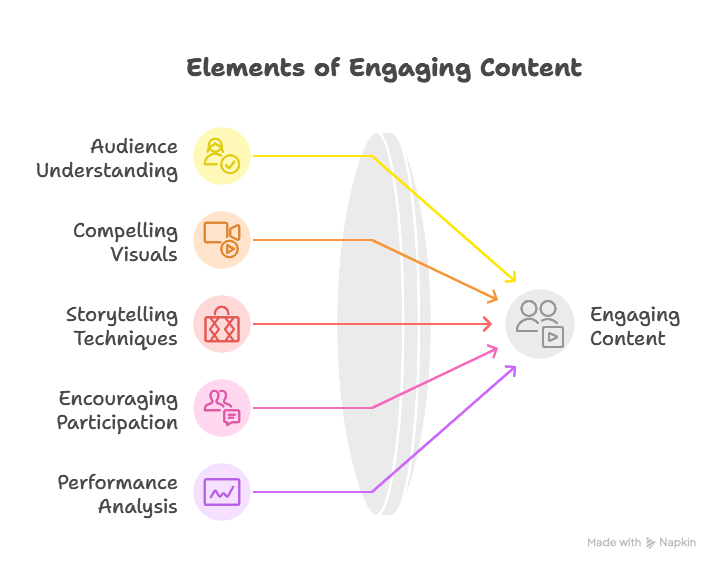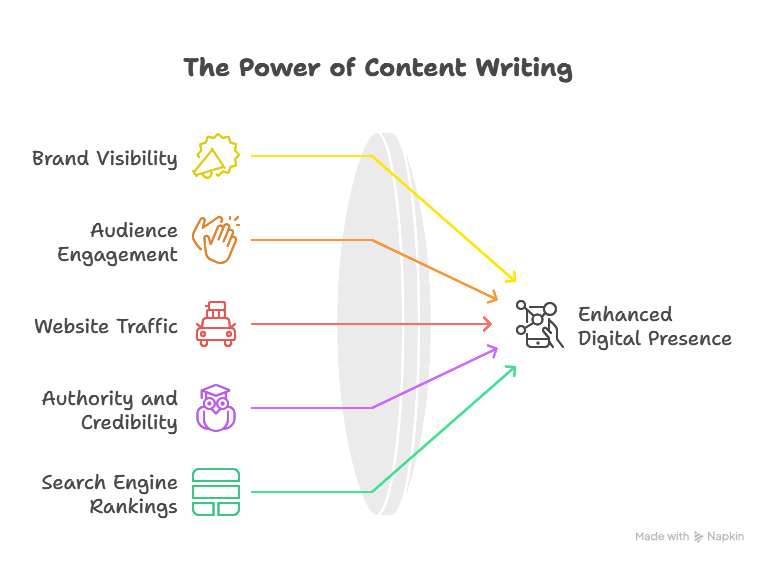How to Create Engaging Content Your Audience Will Like
Table of Contents

In today’s online world, “engagement” is the true money of content. Likes, comments, shares, and watch time aren’t vanity metrics anymore—these define reach, influence, and ultimately, trust. Here’s an interesting stat: research indicates that the average human attention span on the web is under 9 seconds, shorter than a goldfish’s. That is to say, if your content doesn’t resonate almost immediately, your audience scrolls on.
The challenge is not how to create more content but how to create compelling content that initiates engagement and loyalty. Businesses and creators must, therefore, look beyond shallow facts and concentrate on establishing real connections. Strategy and creativity should be balanced in this process.
In this blog, we’ll uncover how to increase content engagement by understanding your audience, using storytelling, choosing the right formats, optimizing for search and readability, and measuring results. By the end, you’ll know exactly how to make content engaging—not just clickable, but memorable and share-worthy.
1. Understanding Your Audience
All good content starts with one simple step: understanding who you’re writing to. Audience research is the key to any successful plan because without it, even the most polished words can fall short. If you’re interested in knowing how to drive content engagement, you first have to understand what your audience actually cares about.
Practical techniques involve conducting surveys and polls, monitoring website and social media metrics, and engaging in social listening to track what people are saying in your space. These methods unveil preferences, frustrations, and habits that inform your strategy for developing engaging content.
One such best working tool could be the creation of audience personas—fictional but research-based profiles of ideal readers or viewers. Personas may encompass age brackets, job positions, primary interests, and typical pain points. For example, learning how to write engaging blog content would highlight a persona whose perspective on writing includes quick tips, easy-to-understand examples, and concrete takeaways for real-world application.
When you ground your content in actual audience needs, you establish relevance and trust. That’s how you crack the code on making content interesting—not by guessing, but by serving up just what works.

2. Choosing the Right Content Formats
The format you choose can determine whether your content engages readers. Written pieces like blogs and articles remain valuable because they build authority and provide depth. They’re also an effective way to practice writing engaging blog content, especially when you include a clear structure, examples, and practical tips.
Visual formats, such as infographics, short videos, and carousels, have gained popularity. They quickly capture attention and simplify complex ideas, making them ideal for fast-scrolling audiences.
Interactive formats, like polls, quizzes, or calculators, create two-way communication. This approach is one of the best ways to engage content. They entertain and provide insights into your audience’s preferences.
The key is to choose formats that fit where your audience spends time and how they prefer to receive information. Meeting them on their terms ensures your message doesn’t just get seen—it gets remembered.
3. Storytelling for Connection
At the core of engaging content is storytelling. Facts inform, but stories create connections. By crafting relatable narratives, you turn abstract ideas into real experiences. For creators learning to write engaging blog content, adding stories helps information stick and gives readers a reason to care.
Effective storytelling combines emotion and logic. You can build trust by showing the human side of a brand and backing claims with data. This balance makes stories both credible and appealing when you want to make content engaging.
A useful technique is the “hook-problem-solution” method. Begin with a strong hook, present a familiar problem, and then offer a solution. This narrative structure mirrors the customer journey and effectively boosts retention.
Examples abound: healthcare brands sharing patient experiences, tech companies showcasing user success, or nonprofits demonstrating real-world impact. Each shows that creating engaging content often involves telling a story your audience can relate to. When people feel connected, they engage, share, and remain involved.
4. Writing Techniques That Engage
The greatest ideas are meaningless if the writing doesn’t grab people. For that reason, learning certain techniques is necessary for writing compelling content. It begins with headlines and beginnings. A great headline creates curiosity, and an introduction that cuts to the chase builds the foundation for writing compelling blog posts that readers actually complete.
Tone also matters. A conversational style feels relatable and keeps readers hooked, while jargon-heavy writing risks losing them. If you’re focused on how to make content engaging, simplicity and clarity always win.
Structure plays a major role, too. Short paragraphs, bullet points, and clear subheads make content easy to scan—critical for online audiences with limited time. By designing your writing for quick consumption, you’ll see how to increase content engagement across different platforms.
Lastly, don’t neglect CTAs. Your call to action should be natural, never contrived. If it’s asking readers to leave an opinion, download a free guide, or check out a related piece, the most effective CTAs harmonize with the rhythm of your article. Together, these methods make your words informative as well as provoke action—transforming passive readers into active contributors.

5. Visual & Design Elements
Words alone cannot produce content that is really engaging—images have a significant role in grabbing and holding on to attention. From infographics to short videos, images make things more memorable and enable us to see how to make content engaging without text.
Consistency is key. Using brand colors, typography, and a cohesive design style builds recognition and trust. For example, if you’re exploring how to write engaging blog content, embedding branded graphics or diagrams can reinforce your message while keeping readers interested.
Practicalities are important as well. Images and video must be optimized to load quickly; otherwise, even the most innovative designs won’t engage. To simplify the process, creators can utilize software like Canva, Figma, or Adobe Express to produce attractive content that is professional-looking without requiring expert design abilities.
In brief, visuals are not merely aesthetic—they’re a strategy. If you wish to learn how to get more content engagement, combining great design and great copy guarantees that your audience doesn’t merely browse but lingers.
6. Leveraging Trends and Timeliness
One of the best ways to create engaging content is by making it timely. Relevance drives shareability. When people see something related to current events, cultural discussions, or a trending meme, they are much more likely to interact. This helps you learn how to boost content engagement without constantly starting from scratch.
That said, timeliness should be planned. While posts based on trends give quick bursts of visibility, evergreen content maintains traffic over the long term. Balancing both ensures your strategy addresses immediate interests and ongoing relevance.
For anyone looking to make their content engaging, incorporating your brand’s voice into trending topics helps you feel part of the conversation while staying authentic. Whether commenting on industry changes or joining a cultural moment, timeliness keeps your content fresh, relatable, and shareable. This is the key to creating engaging content that feels alive.
7. SEO and Discoverability
Even the most engaging content needs to be found to make an impact. This is where SEO becomes your best friend. Keyword research connects your audience’s search intent with your message, showing you how to write engaging blog content that answers real questions.
Organizing posts using SEO best practices—such as H2 and H3 subheads, descriptive meta tags, and internal linking—boosts both readability and ranking. These methods indicate to search engines that your content is well-organized, while also helping readers scan easily. This is a win-win when finding ways to increase content engagement.
But optimization doesn’t mean writing for robots. Writing for humans comes first. Algorithms now favor clarity, originality, and real value. To enhance your approach, adding FAQs or schema markup can improve visibility in search results, which may significantly increase clicks.
When you balance discoverability with audience needs, you learn how to create content that engages both people and search engines. This is the true connection between SEO and storytelling in producing engaging content.
8. Encouraging Interaction
Engaging content actually doesn’t speak at people; it talks with them. Incorporating polls, Q&A, or basic comment questions encourages readers to feel engaged and appreciated. It’s an easy means of discussing ways to boost content engagement without overcomplicating your approach.
User-generated content is another useful weapon. Asking your readers to post their experiences, photos, or comments creates authenticity and new content for your brand. It’s evidence that having great content usually comes from working together, not broadcasting.
Equally important is responsiveness. Replying to comments, acknowledging feedback, or starting discussions shows you’re listening. When people feel heard, they’re far more likely to return and interact again. If you’ve been wondering how to make content engaging, the answer often lies in building a sense of community around your content, not just the content itself.
9. Measuring What Works
To become proficient in writing compelling blog posts, you must understand what’s working. Measurement is the link to outcome. Begin with the fundamentals such as click-through rate (CTR), time on page, social shares, and conversions. These are the figures that show your compelling content is striking the right note.
Anchors like Google Analytics, social platform insights, and even heatmaps provide granular images of user behavior. They point out what topics, headlines, or images are driving engagement—indicating the way to boost content engagement with precision.
Experimentation is also a big contributor. A/B testing varying headlines, formats, or CTAs can yield surprising learnings. Small changes tend to reveal how to make content engaging in ways you wouldn’t have imagined.
The aim isn’t perfection but iteration. By learning, morphing, and refining, you continue to get better at your skill for creating compelling content that only gets stronger with each post.
10. Best Practices & Pitfalls to Avoid
When learning to create engaging content, consistency is key, but avoid being repetitive. Fresh ideas and formats keep readers interested.
Clickbait is a major pitfall. While it may attract clicks, it damages trust, making it more difficult to improve content engagement over time.
Balance is also important. Focus on quality while keeping a regular publishing schedule. Remember accessibility—using clear fonts, providing alt text for images, and ensuring easy navigation helps you create engaging content for everyone.
By avoiding these traps, you’ll refine your ability to write engaging blog content that provides real value, not just quick views.
Conclusion
In today’s fast-paced digital world, the secret to creating engaging content is understanding your audience, sharing compelling stories, choosing the right formats, and optimizing for both people and search engines. Measurement and interaction close the loop, allowing you to keep learning how to improve content engagement over time.
At its heart, engaging content builds trust, loyalty, and stronger relationships with your audience. It’s not just about reach; it’s about connection. If you’ve been wondering how to make content engaging, the strategies we’ve discussed—from storytelling to SEO to building community—provide a practical way forward.
As a next step, review your current content. Find 2–3 areas where you can apply these techniques right away. That’s how you’ll shift from merely publishing to truly creating engaging blog content that makes a lasting impact.
Frequently Asked Questions
How to come up with engaging content?
Begin by learning about what fascinates your audience, their questions, and their pains. Apply these observations to write stories, tips, or formats that invite curiosity and discussion.
How to create engaging learning content?
Combine straightforward explanations with graphics, illustrations, and engaging elements such as quizzes. Keeping the narrative friendly keeps students engaged and interested.
How to create engaging content on Instagram?
Make use of reels, carousels, and stories with engaging visuals and captions that prompt responses. Regularity and timely topics enhance visibility and engagement.
What content is most engaging?
Educating, entertaining, or solving genuine problems with content tends to do best. Incorporating storytelling and interactive elements makes it even more shareable.
What is high engagement content?
High engagement content is content that consistently receives likes, shares, comments, and saves. It creates bonds through active audience participation and trust.


















